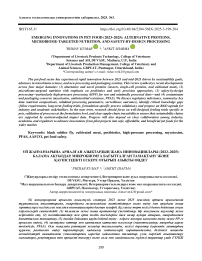Emerging innovations in pet food (2023–2025): alternative proteins, microbiome-targeted nutrition, and safety-by-design processing
Автор: Kumar R., Sharma A.
Журнал: Вестник Алматинского технологического университета @vestnik-atu
Рубрика: Технология пищевой и перерабатывающей промышленности
Статья в выпуске: 3 (149), 2025 года.
Бесплатный доступ
The pet-food sector has experienced rapid innovation between 2023 and mid-2025 driven by sustainability goals, advances in microbiome science, and new processing and packaging scrutiny. This review synthesizes recent developments across four major domains: (1) alternative and novel proteins (insects, single-cell proteins, and cultivated meat), (2) microbiome-targeted nutrition with emphasis on postbiotics and early precision approaches, (3) safety-by-design processing—particularly high-pressure processing (HPP) for raw and minimally processed diets—and (4) contaminant and packaging concerns (mycotoxins, antimicrobial resistance, PFAS). We discuss regulatory milestones, summarize key data (nutrient compositions, validated processing parameters, surveillance outcomes), identify critical knowledge gaps (feline requirements, long-term feeding trials, formulation-specific process validation), and propose an R&D agenda for industry and academic stakeholders. In the near term, research should focus on well-designed feeding trials specific to pets, validation of processes at the formulation level, and clear supply-chain traceability to ensure that sustainability claims are supported by nutrient-adjusted impact data. Progress will also depend on close collaboration among industry, academia, and regulators to advance innovations from pilot projects into safe, affordable, and beneficial pet foods for the wider market.
Black soldier fly, cultivated meat, postbiotics, high-pressure processing, mycotoxins, PFAS, AAFCO, pet food safety
Короткий адрес: https://sciup.org/140312206
IDR: 140312206 | УДК: 65.31 | DOI: 10.48184/2304-568X-2025-3-199-204


